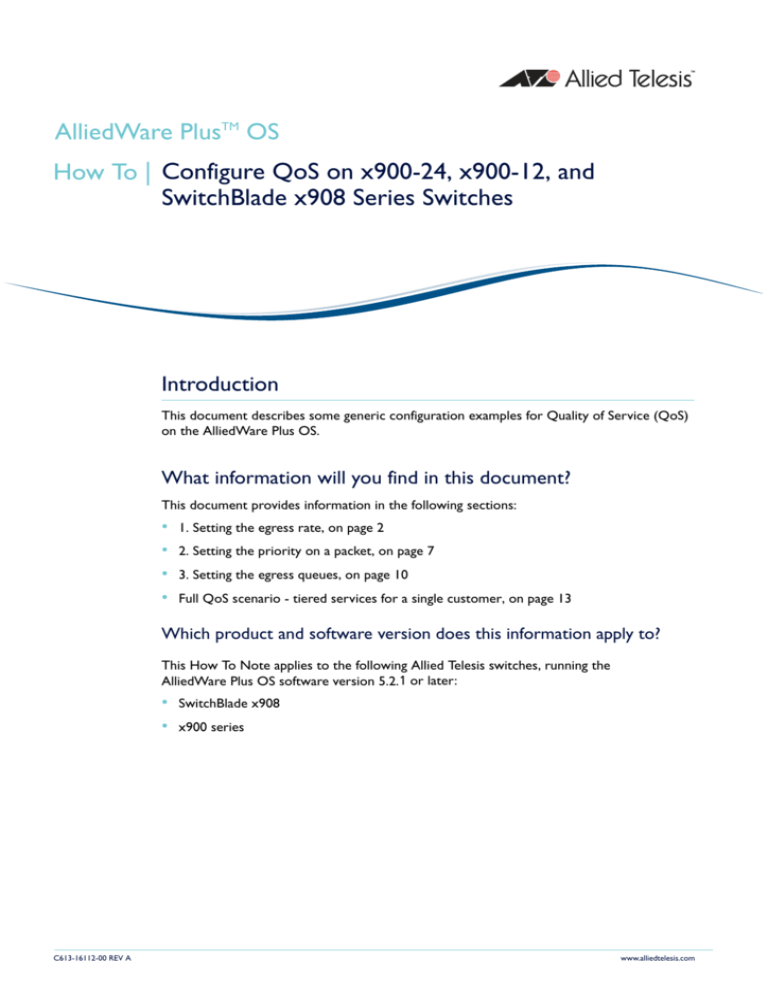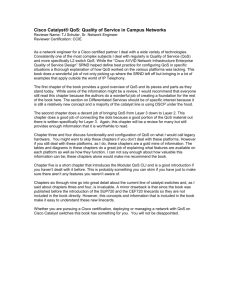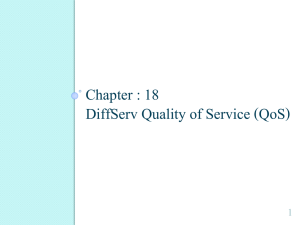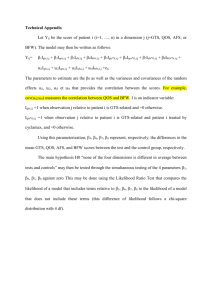
AlliedWare PlusTM OS
How To | Configure QoS on x900-24, x900-12, and
SwitchBlade x908 Series Switches
Introduction
This document describes some generic configuration examples for Quality of Service (QoS)
on the AlliedWare Plus OS.
What information will you find in this document?
This document provides information in the following sections:
•
•
•
•
1. Setting the egress rate‚ on page 2
2. Setting the priority on a packet‚ on page 7
3. Setting the egress queues‚ on page 10
Full QoS scenario - tiered services for a single customer‚ on page 13
Which product and software version does this information apply to?
This How To Note applies to the following Allied Telesis switches, running the
AlliedWare Plus OS software version 5.2.1 or later:
•
•
C613-16112-00 REV A
SwitchBlade x908
x900 series
www.alliedtelesis.com
1. Setting the egress rate
1. Setting the egress rate
Example 1-1: Setting the egress limit of a switch port
Port 24
Commands:
interface port1.0.24
egress-rate-limit 25m
These commands will set the egress limit of port 24 to 25Mbps. The granularity is 651kbps.
Page 2 | AlliedWare Plus™ OS How To Note: QoS
1. Setting the egress rate
Example 1-2: setting the maximum bandwidth limit per ingress port
Ingress rate limiting cannot be configured on the port per se, but is achieved by creating a QoS
policy with a bandwidth limited traffic class, and applying that policy to each port.
Port 24
Ingress ports 1-20
mls qos enable
class-map cmap1
policy-map pmap1
class cmap1
police single-rate
policy-map pmap2
class cmap1
police single-rate
policy-map pmap3
class cmap1
police single-rate
.
.
.
policy-map pmap20
class cmap1
police single-rate
128 3000 5000 exceed-action drop
256 3000 5000 exceed-action drop
64 3000 5000 exceed-action drop
interface port1.0.1
service-policy input
interface port1.0.2
service-policy input
interface port1.0.3
service-policy input
.
.
.
interface port1.0.20
service-policy input
512 3000 5000 exceed-action drop
pmap1
pmap2
pmap3
pmap20
This set of commands will set the ingress rate of traffic received per port from ports 1 to 20 to
various different values. Note that the class-map matches EVERY packet. The granularity of the rate
limiting is around 1 kbps.
Page 3 | AlliedWare Plus™ OS How To Note: QoS
1. Setting the egress rate
Example 1-3: Setting the maximum bandwidth limit for each user
In example 1-1, we configured an egress rate on ports. But the granularity of that bandwidth limiting
was multiples of 651kbps. It is possible to achieve finer-grained limiting using the devices advanced
QoS capability. In this example we assume that there is one device with a known IP address,
attached to each port. Policers will be configured to provide bandwidth limiting.
Port 24
Internet
connection
Users connected to the switch downloading files from the Internet
(192.168.1.1-192.168.1.25)
mls qos enable
access-list 3011 permit ip any 192.168.1.1/32
access-list 3012 permit ip any 192.168.1.2/32
access-list 3013 permit ip any 192.168.1.3/32
.
.
.
class-map cmap1
match access-group 3011
class-map cmap2
match access-group 3012
class-map cmap3
match access-group 3013
.
.
.
policy-map pmap1
class cmap1
police single-rate 256 3000 5000 exceed-action drop
class cmap2
police single-rate 256 3000 5000 exceed-action drop
class cmap3
police single-rate 256 3000 5000 exceed-action drop
.
.
.
interface port1.0.24
service-policy input pmap1
This set of commands will set the total egress limit (download traffic) for each user to 256kbps. The
granularity is around 1kbps.
Page 4 | AlliedWare Plus™ OS How To Note: QoS
1. Setting the egress rate
Example 1-4: Setting the maximum bandwidth limit for each IP subnet
This example is very similar to example 1-3, except that it is assumed that a whole subnet is
attached to each port, not just a single device on each port.
Port 24
Internet
connection
Users connected to the switch downloading files from the Internet
(192.168.1.0/24 - 192.168.23.0/24)
mls qos enable
access-list 3011 permit ip any 192.168.1.0/24
access-list 3012 permit ip any 192.168.1.0/24
access-list 3013 permit ip any 192.168.1.0/24
.
.
.
class-map cmap1
match access-group 3011
class-map cmap2
match access-group 3012
class-map cmap3
match access-group 3013
.
.
.
policy-map pmap1
class cmap1
police single-rate 256 3000 5000 exceed-action drop
class cmap2
police single-rate 256 3000 5000 exceed-action drop
class cmap3
police single-rate 256 3000 5000 exceed-action drop
.
.
.
interface port1.0.24
service-policy input pmap1
This set of commands will set the total egress limit (download traffic) for each subnet to 256kbps.
The granularity is around 1kbps.
Page 5 | AlliedWare Plus™ OS How To Note: QoS
1. Setting the egress rate
Example 1-5: Setting the maximum bandwidth limit of VLANs
Port 24
Ingress ports 1-20 (these ports are carrying a mixture of
VLAN2, VLAN3 and VLAN4 packets, either with or without VLAN tags)
mls qos enable
class-map cmap2
match vlan 2
class-map cmap3
match vlan 3
class-map cmap4
match vlan 4
mls
mls
mls
mls
qos
qos
qos
qos
enable
aggregate-police agg1 single-rate 256 3000 5000 exceed-action drop
aggregate-police agg2 single-rate 256 3000 5000 exceed-action drop
aggregate-police agg3 single-rate 256 3000 5000 exceed-action drop
policy-map pmap1
class cmap2
police aggregate agg1
class cmap3
police aggregate agg2
class cmap4
police aggregate agg3
interface port1.0.1-1.0.20
service-policy input pmap1
Page 6 | AlliedWare Plus™ OS How To Note: QoS
2. Setting the priority on a packet
2. Setting the priority on a packet
Example 2-1: Setting the Layer 2 (VLAN/802.1p) priority per ingress port
Here we assign different 802.1p values to packets arriving on different ports.
These values are also known as the Layer 2 (L2) or VLAN priority.
Port 24
Ingress ports 1-20 (these ports MAY be carrying a mixture of
packets from different VLANs, either with or without VLAN tags)
mls qos enable
class-map cmap1
policy-map pmap1
class cmap1
set cos 6
policy-map pmap2
class cmap1
set cos 5
policy-map pmap3
class cmap1
set cos 4
.
.
.
interface port1.0.1
service-policy input pmap1
interface port1.0.2
service-policy input pmap2
interface port1.0.3
service-policy input pmap3
.
.
.
Page 7 | AlliedWare Plus™ OS How To Note: QoS
2. Setting the priority on a packet
Example 2-2: Setting the Layer 2 (VLAN/802.1p) priority per VLAN
Port 24
Ingress ports 1-20 (these ports MAY be carrying a mixture of VLAN2,
VLAN3, and VLAN4 packets either with or without VLAN tags)
mls qos enable
class-map cmap2
match vlan 2
class-map cmap3
match vlan 3
class-map cmap4
match vlan 4
policy-map pmap1
class cmap2
set cos 6
class cmap3
set cos 5
class cmap4
set cos 4
interface port1.0.1-1.0.20
service-policy input pmap1
This set of commands will set the Layer 2 priority of VLAN2, VLAN3 and VLAN4 traffics packets,
received on ports 1 to 20, to 6, 5 and 4 respectively.
Page 8 | AlliedWare Plus™ OS How To Note: QoS
2. Setting the priority on a packet
Example 2-3: Setting the Layer 3 (TOS/DCSP) priority per ingress port
Use the same configuration provided in Example 2-1 on page 7, but change the following line:
set cos <cos-value>
to
set dscp <dscp-value>
Example 2-4: Setting the Layer 3 (TOS/DSCP) priority per VLAN
Use the same configuration provided in Example 2-2 on page 8, but change the following line:
set cos <cos-value>
to
set dscp <dscp-value>
Page 9 | AlliedWare Plus™ OS How To Note: QoS
3. Setting the egress queues
3. Setting the egress queues
In this section we look at methods for directing certain packets into certain queues on the egress
port.
Example 3-1: Setting the egress queue according to the L2 priority of the
incoming packet
The priority-to-queue map is a straightforward method for assigning packets to egress queues on
the basis of the packets’ 802.1p values.
Port 24
Ingress ports 1-20 (these ports MAY be carrying a mixture of packets
from different VLAN packets either with or without VLAN tags)
mls qos enable
mls
mls
mls
mls
mls
mls
mls
mls
qos
qos
qos
qos
qos
qos
qos
qos
map
map
map
map
map
map
map
map
cos-queue
cos-queue
cos-queue
cos-queue
cos-queue
cos-queue
cos-queue
cos-queue
0
1
2
3
4
5
6
7
2
3
1
0
4
5
6
7
interface port1.0.1-port1.0.20
mls qos queue 2
Command
settings
The map cos-queue commands in the above example set the mapping between the VLAN Tag
User Priorities of the packets and the egress queues. Priorities 0 to 7 are mapped to queues 2, 3, 1,
0, 4, 5, 6 and 7 respectively.
The Interface mode command sets the incoming ports to send untagged packets to queue number
2, which means the untagged packets will use the same queue as the tagged packets with a User
Priority of 1.
Page 10 | AlliedWare Plus™ OS How To Note: QoS
3. Setting the egress queues
Example 3-2: Setting the egress queue according to the ingress port
Port 24
Ingress ports 1-20 (these ports MAY be carrying a mixture of packets
from different VLAN packets either with or without VLAN tags)
mls qos enable
class-map cmap1
policy-map pmap1
class cmap1
set queue 6
policy-map pmap2
class cmap1
set queue 5
policy-map pmap3
class cmap1
set queue 4
interface port1.0.1
service-policy input pmap1
interface port1.0.2
service-policy input pmap2
interface port1.0.3
service-policy input pmap3
.
.
.
This set of commands will set the egress queue of any traffic received from port 1 to egress queue
6, from port 2 to egress queue 5 … etc.
Page 11 | AlliedWare Plus™ OS How To Note: QoS
3. Setting the egress queues
Example 3-3: Configuring WRR for egress queues
This example is used for configuring WRR on egress queues according to the ingress port of the
traffic.
Port 24
Ingress ports 1-3 (these ports MAY be carrying a mixture of packets
from different VLAN packets either with or without VLAN tags)
class-map cmap1
policy-map pmap1
class cmap1
set queue 6
policy-map pmap2
class cmap1
set queue 5
policy-map pmap3
class cmap1
set queue 4
interface port1.0.1
service-policy input pmap1
interface port1.0.2
service-policy input pmap2
interface port1.0.3
service-policy input pmap3
interface port1.0.24
wrr-queue group 1 weight 6 queues 4
wrr-queue group 1 weight 12 queues 5
wrr-queue group 1 weight 24 queues 6
This set of commands will set the egress queue of any traffic received from port 1 to egress queue
6, from port 2 to egress queue 5 and from port 3 to egress queue 4. And on egress, the WRR
algorithm will do the following: for every 4 packets from queue 6, 2 packets will leave queue 5 and 1
packet will leave queue 4.
Page 12 | AlliedWare Plus™ OS How To Note: QoS
Full QoS scenario - tiered services for a single customer
Full QoS scenario - tiered services for a single customer
In this section, we will build up a relatively complex QoS configuration to support a scenario
requiring quite precise control over the traffic passing through the switch.
The scenario is an ISP providing connectivity for a customer, and offering different levels of service
for different types of traffic.
The customer is connected to port 1 of the switch, and the uplink to the ISP is on port 24 of the
switch.
ISP
Port 24
uplink to the ISP
Customer LAN
X Step 1 - Set the egress bandwidth limiting
The service offered by the ISP puts a limit on the total bandwidth of traffic that the customer can
send to the ISP.
This is achieved by setting a maximum bandwidth on the uplink port:
interface port1.0.24
egress-rate-limit 10m
X Step 2 - Give better service to some types of traffic than to others
The deal offered to the customer is that their traffic will be treated as belonging to three categories,
and each category of traffic will be given a different level of service:
Gold traffic will be limited to, say, 2Mbps, but the ISP will guarantee delivery of the traffic across
their network, with a low latency.
Silver traffic will have a much higher limit, but when congestion occurs, it will be throttled back in
favour of Gold traffic, if necessary. The ISP will guarantee to deliver up to, say 5Mbps of Silver traffic
across its network 90% of the time, but will give no guarantees about latency.
Bronze traffic will also have a high burst limit, but when congestion occurs, will be throttled back
in favour of Gold traffic, and will share the remaining bandwidth with Silver traffic in a Weighted
Round Robin fashion. The ISP makes no guarantees at all with regard to delivery of Bronze traffic
across their network; it will be delivered on a best-effort basis.
Page 13 | AlliedWare Plus™ OS How To Note: QoS
Full QoS scenario - tiered services for a single customer
Identify the types of traffic
The different categories of traffic will be identified by the DSCP values in the packets' headers. It is
up to the customer to mark the packets with the appropriate DSCP values.
The DSCP values belonging to the different traffic categories are:
Gold
40
Silver
30
Bronze
0
The class maps to match these DSCP values are:
class-map cmap1
match ip-dscp 0
class-map cmap2
match ip-dscp 30
class-map cmap3
match ip-dscp 40
X Put the different categories of trafffic into different queues
This inolves creating a policy-map, assigning the 3 class maps, and assigning the policy-map to a port.
policy-map pmap1
class cmap1
set queue 1
class cmap2
set queue 2
class cmap3
set queue 6
interface port1.0.1
service-policy input pmap1
Page 14 | AlliedWare Plus™ OS How To Note: QoS
Full QoS scenario - tiered services for a single customer
X Set the required properties on the egress queues
What is required is that:
•
Gold traffic ALWAYS has precedence over Silver or Bronze traffic. So, when a Gold packet arrives
at the egress port, it is transmitted immediately, irrespective of how many Silver or Bronze
packets might be queued up.
•
When there are Silver and Bronze packets queued up, they are transmitted according to a
Weighted Round Robin (WRR) scheme.
This is achieved by ensuring that the egress queue to which Gold traffic is directed to is a priority
queue, and the egress queues to which the silver and bronze traffic are directed are WRR queues.
So, we need to specify the queue types of queues 1, 2, and 6 on port 24. The relative weights to
give to Silver and Bronze traffic are set by specifying the WRR weight for their queues. For example,
to give a 4:1 ratio of Silver to Bronze traffic:
interface port1.0.24
priority-queue 6
wrr-queue group 1 weight 6 queues 1
wrr-queue group 1 weight 24 queues 2
X Step 3 - set the bandwidth limits
The Gold traffic must be strictly limited to 2Mbps.
This is achieved by configuring a maxbandwidth on that traffic class, and dropping bandwidthclass 3
traffic:
policy-map pmap1
class cmap1
police single-rate 2000 15000 20000 exceed-action drop
For silver traffic, there is preferential treatment for the first 5Mbps of traffic. So, when there is
congestion, you want to still be getting 5Mbps of Silver traffic through, if possible.
This is achieved by putting bandwidth limits on both Silver and Bronze traffic, and using RED curves
to shape the throughput back to those limits when congestion occurs.
class cmap2
police single-rate 5000 25000 30000 exceed-action none
class cmap3
police single-rate 10000 100000 125000 exceed-action none
mls qos queue-set 1 queues 1 threshold 20000 50000 5000 10000 2000 6000
mls qos queue-set 1 queues 2 threshold 40000 60000 7000 12000 5000 10000
interface port1.0.24
mls qos queue-set 1 random-detect
Page 15 | AlliedWare Plus™ OS How To Note: QoS
X Full configuration script
mls qos enable
mls qos queue-set 1 queues 1 threshold 20000 50000 5000 10000 2000 6000
mls qos queue-set 1 queues 2 threshold 40000 60000 70000 120000 5000
10000
class-map cmap1
match ip-dscp 0
!
class-map cmap2
match ip-dscp 30
!
class-map cmap3
match ip-dscp 40
!
policy-map pmap1
class default
class cmap1
set queue 1
police single-rate 2000 15000 20000 exceed-action drop
class cmap2
set queue 2
police single-rate 5000 25000 30000 exceed-action none
class cmap3
set queue 3
police single-rate 10000 100000 125000 exceed-action none
interface port1.0.1
service-policy input pmap1
interface port1.0.24
egress-rate-limit 10416
mls qos queue-set 1 random-detect
wrr-queue group 1 weight 6 queues 1
wrr-queue group 1 weight 24 queues 2
USA Headquarters | 19800 North Creek Parkway | Suite 200 | Bothell | WA 98011 | USA | T: +1 800 424 4284 | F: +1 425 481 3895
European Headquarters | Via Motta 24 | 6830 Chiasso | Switzerland | T: +41 91 69769.00 | F: +41 91 69769.11
Asia-Pacific Headquarters | 11 Tai Seng Link | Singapore | 534182 | T: +65 6383 3832 | F: +65 6383 3830
www.alliedtelesis.com
© 2007 Allied Telesis, Inc. All rights reserved. Information in this document is subject to change without notice. Allied Telesis is a trademark or registered trademark of Allied Telesis, Inc. in the United States and other countries.
All company names, logos, and product designs that are trademarks or registered trademarks are the property of their respective owners.
C613-16112-00 REV A









